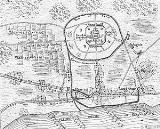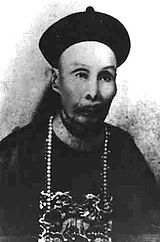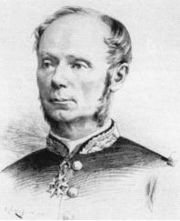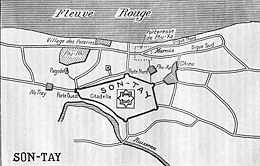
Son Tay Campaign
Encyclopedia
- Not to be confused with Tây Sơn Rebellion
The Son Tay Campaign (December 1883) was a campaign fought by the French to capture the strategically important city of Son Tay
Son Tay
Sơn Tây is an urban district and city in Hanoi, the capital of Vietnam. It was the capital of Son Tay province before merging with Ha Dong province in 1965...
in Tonkin (northern Vietnam) from Liu Yongfu's Black Flag Army
Black Flag Army
The Black Flag Army was a splinter remnant of a bandit group recruited largely from soldiers of ethnic Zhuang background, who crossed the border from Guangxi province of China into Upper Tonkin, in the Empire of Annam in 1865. They became known mainly for their fights against French forces in...
and allied contingents of Vietnamese and Chinese troops. The campaign was one of several clashes between the Tonkin Expeditionary Corps
Tonkin Expeditionary Corps
The Tonkin Expeditionary Corps was an important French military command based in northern Vietnam from June 1883 to April 1886. The expeditionary corps fought the Tonkin campaign taking part in campaigns against the Black Flag Army and the Chinese Yunnan and Guangxi Armies during the...
and the Black Flag Army
Black Flag Army
The Black Flag Army was a splinter remnant of a bandit group recruited largely from soldiers of ethnic Zhuang background, who crossed the border from Guangxi province of China into Upper Tonkin, in the Empire of Annam in 1865. They became known mainly for their fights against French forces in...
during the Tonkin campaign
Tonkin campaign
The Tonkin Campaign was a armed conflict fought between June 1883 and April 1886 by the French against, variously, the Vietnamese, Liu Yongfu's Black Flag Army and the Chinese Guangxi and Yunnan armies to occupy Tonkin and entrench a French protectorate there...
(1883–1886), and took place during the period of undeclared hostilities that preceded the Sino-French War
Sino-French War
The Sino–French War was a limited conflict fought between August 1884 and April 1885 to decide whether France should replace China in control of Tonkin . As the French achieved their war aims, they are usually considered to have won the war...
(August 1884–April 1885).
Background
Following the defeat and death of the French naval captain Henri Rivière at the Battle of Paper BridgeBattle of Paper Bridge
The Battle of Cầu Giấy or Paper Bridge, fought on 19 May 1883, was one of the numerous clashes during the Tonkin campaign between the French and the Black Flags...
on 19 May 1883 at the hands of Liu Yongfu and the Black Flag Army
Black Flag Army
The Black Flag Army was a splinter remnant of a bandit group recruited largely from soldiers of ethnic Zhuang background, who crossed the border from Guangxi province of China into Upper Tonkin, in the Empire of Annam in 1865. They became known mainly for their fights against French forces in...
, the French government sent substantial reinforcements to Tonkin. General Alexandre-Eugène Bouët (1833–87), Rivière's successor, attempted to destroy the Black Flag Army in the summer and autumn of 1883, but although the Black Flags suffered substantial losses in the Battle of Phu Hoai
Battle of Phu Hoai
The Battle of Phu Hoai was an indecisive engagement between the Tonkin Expeditionary Corps and Liu Yongfu's Black Flag Army during the early months of the Tonkin campaign...
(15 August) and the Battle of Palan
Battle of Palan
The Battle of Palan was one of several clashes between the Tonkin Expeditionary Corps and Liu Yongfu's Black Flag Army during the Tonkin campaign...
(1 September), the French failed to defeat them decisively. In October 1883 command of the Tonkin Expeditionary Corps
Tonkin Expeditionary Corps
The Tonkin Expeditionary Corps was an important French military command based in northern Vietnam from June 1883 to April 1886. The expeditionary corps fought the Tonkin campaign taking part in campaigns against the Black Flag Army and the Chinese Yunnan and Guangxi Armies during the...
was given to Admiral Amédée Courbet
Amédée Courbet
Anatole-Amédée-Prosper Courbet was a French admiral who won a series of important land and naval victories during the Tonkin campaign and the Sino-French War .-Early years:...
. The French now prepared for a major offensive at the end of the year to annihilate the Black Flags, and tried to persuade China to withdraw its support for Liu Yongfu, while attempting to win the support of the other European powers for the projected offensive. Jules Ferry and the French foreign minister Paul-Armand Challemel-Lacour
Paul-Armand Challemel-Lacour
Paul-Armand Challemel-Lacour was a French statesman.-Biography:He was born in Avranches in the Manche département of northwestern France. After passing through the École Normale Supérieure he became professor of philosophy successively at Pau and at Limoges...
met a number of times in the summer and autumn of 1883 with the Chinese minister Marquis Zeng Jize
Zeng Jize
Marquis Zeng Jize , one of China's earliest ministers to London, Paris and Saint Petersburg, played an important role in the diplomacy that preceded and accompanied the Sino-French War .- Early career :Zeng Jize , a native of Hunan province, was the eldest son of Zeng Guofan...
in Paris, but these diplomatic discussions proved abortive. The Chinese stood firm, and refused to withdraw substantial garrisons of Chinese regular troops from Son Tay, Bac Ninh and Lang Son, despite the likelihood that they would be shortly engaged in battle against the French. In turn, the French consolidated their hold on the Delta by establishing posts at Quang Yen, Hung Yen and Ninh Binh
Ninh Bình
Ninh Bình is a city in the Red River Delta of northern Vietnam. It is the capital of Ninh Binh province.-Geography:Ninh Binh city located in the southernmost plains north Vietnam...
. In December 1883 Admiral Courbet was authorised by Ferry's government to attack Son Tay. The French cabinet accepted that an attack on Liu Yongfu would probably result in an undeclared war with China, but calculated that a quick victory in Tonkin would force the Chinese to accept a fait accompli.
The forces


To remain in contact with the flotilla, the French were bound to approach Son Tay from the east, with their right flank lying on the Red River. In theory, they could march past Son Tay on its northern side, squeezing their columns between the town and the river, and deploy for an attack on the vulnerable acute angle where the two long walls met to the west of the town. However, the defenders had done their best to ensure that they would never get there. The dyke paths leading to Son Tay from the Day River converged at the village of Phu Sa, just to the northeast of the town. The Black Flags had hired European engineers to convert Phu Sa into an impregnable strongpoint. Water-filled ditches, bamboo palisades and trenches surrounded a central redoubt, and subsidiary defences hampered the approach to the main position. From the Phu Sa strongpoint, the Black Flags had an excellent field of fire both out to the east, from where the initial French attack was likely to come, and north to the Red River. To deploy to the north and west of Son Tay, the French would first have to capture Phu Sa. This would not be an easy task, as Liu Yongfu had strongly garrisonned the village and packed it with cannon. The cannon were dug in beneath casemates, making them a difficult target to knock out.

Admiral Amédée Courbet
Amédée Courbet
Anatole-Amédée-Prosper Courbet was a French admiral who won a series of important land and naval victories during the Tonkin campaign and the Sino-French War .-Early years:...
led the bulk of the Tonkin Expeditionary Corps
Tonkin Expeditionary Corps
The Tonkin Expeditionary Corps was an important French military command based in northern Vietnam from June 1883 to April 1886. The expeditionary corps fought the Tonkin campaign taking part in campaigns against the Black Flag Army and the Chinese Yunnan and Guangxi Armies during the...
to Son Tay. The French deployed around 9,000 men for the campaign, organised into two columns under the respective command of Colonel Belin and Colonel Bichot. Belin's column, 3,300 men strong, consisted of two Turco battalions (chefs de bataillon Jouneau and Letellier), one marine infantry battalion (chef de bataillon Roux) with an attached company of Cochinchinese riflemen, the 1st Foreign Legion Battalion (Lieutenant-Colonel Donnier), 800 Tonkinese riflemen (chef de bataillon Bertaux-Levillain) and three marine artillery batteries.Jouneau’s Turco battalion was the 1st Battalion, 3rd Algerian Rifle Regiment (Captains Godinet, Noirot, Carles and Massip). Letellier’s Turco battalion was the 2nd Battalion, 1st Algerian Rifle Regiment (Captains Servant, Cannebotin, Omar ben Chaouch and Ligrisse). Roux’s marine infantry battalion consisted of the 25th, 26th and 30th Companies, 4th Marine Infantry Regiment (Captains Drouin, Bécourt and Martellière) and the 4th Annamese Rifle Company (Captain Serre de Bazaugour). Donnier's Legion battalion was the 1st Battalion, 1st Foreign Legion Regiment (Captains Conte, Moulinay, Bergounioux and Broussier). The column’s artillery included the 1st, 2nd and 3rd Marine Artillery Batteries bis (Captains Régis, Dupont and Roussel). Bichot's column consisted of three marine infantry battalions (chefs de bataillon Chevallier, Dulieu and Reygasse), each with an attached company of Cochinchinese riflemen, a battalion of fusiliers-marins (capitaine de frégate Laguerre), three marine artillery batteries and a 65-millimetre naval battery.Chevallier’s battalion consisted of the 25th, 28th and 29th Companies, 1st Marine Infantry Regiment (Captains Poulnot, Boulle and Durruthy) and the 1st Annamese Rifle Company (Captain de Beauquesne). Dulieu’s battalion consisted of the 21st, 22nd and 23rd Companies, 2nd Marine Infantry Regiment (Captains Bauche, Cuny and Leverger) and the 2nd Annamese Rifle Company (Captain Doucet). Reygasse’s battalion consisted of the 26th, 29th and 33rd Companies, 3rd Marine Infantry Regiment (Captains Poisot, Noble and Trilha) and the 3rd Annamese Rifle Company (Captain Berger). The column’s artillery included the 4th, 5th and 6th Marine Artillery Batteries bis (Captains Roperh, Péricaud and Dudraille) and lieutenant de vaisseau Amelot’s naval battery.
The campaign

Tonkin Flotilla
The Tonkin Flotilla , a force of despatch vessels and gunboats used for policing the rivers and waterways of the Tonkin Delta, was created in the summer of 1883, during the period of undeclared hostilities that preceded the Sino-French War .-Background:In March 1882, on the eve of Commandant Henri...
(Pluvier, Trombe, Éclair, Hache, Mousqueton and Yatagan) and several steam launches, junks and tugs. On the afternoon of 11 December Bichot's column went ashore on the western bank of the Day River and secured a passage for Belin's slower-moving column. Meanwhile, Belin's column marched over Paper Bridge and through the villages of Phu Hoai, Kien Mai and Phong, recrossing the battlefields of 19 May and 15 August, and reached the Day River without incident. On 13 December both columns met five kilometres from the forward defences of Son Tay. Belin's men needed rest, and Courbet postponed the battle for Son Tay to the following day.
The battle for Son Tay

Hoping to exploit Courbet's defeat, Liu Yongfu attacked the French lines the same night, but the Black Flag attack also failed disastrously. Liu Yongfu lost so many men in this counterattack that he was obliged to abandon the Phu Sa positions and withdraw into the fortified perimeter of Son Tay. After resting his troops on 15 December, Courbet assaulted the defences of Son Tay from the northwest on the afternoon of 16 December. This time the attack was thoroughly prepared by artillery, and delivered only after the defenders had been worn down. To hearten his troops, Courbet set an example of the utmost personal courage, riding forward to a position well within range of the Black Flag fire. At 5 p.m. Donnier's Foreign Legion battalion and Laguerre's fusiliers-marins captured the western gate of Son Tay and fought their way into the town. Liu Yongfu's garrison withdrew to the citadel, and evacuated Son Tay under cover of darkness several hours later. On the morning of 17 December the French stitched together an enormous tricolour flag from strips of cloth torn from captured Black Flag banners and hoisted it over the citadel of Son Tay while Courbet made a triumphal entry on horseback.
Order of the day
On 17 December 1883 Courbet issued the following order of the day to the soldiers and sailors of the expeditionary corps:
Les forts de Phu-Xa et la citadelle de Son-Tay dont désormais illustrés par votre vaillance. Vous avez combattu, vous avez vaincu un ennemi redoutable.
Vous avez montré une fois de plus au monde entier que la France peut toujours compter sur ses enfants. Soyez fiers de vos succès. Ils assurent la pacification du Tonkin.
(The forts of Phu Sa and the citadel of Son Tay will henceforth be famed for your valour. You have fought and conquered a formidable enemy.
You have once again shown the whole world that France can always count upon her children. Be proud of your successes. They have ensured the pacification of Tonkin.)
Significance
Courbet had achieved his objective, but at considerable cost. Total French casualties during the two days of fighting amounted to 83 dead and 320 wounded. The dead or mortally-wounded officers included Captain Godinet of Jouneau’s Algerian Rifle battalion, Captains Doucet and Cuny and Lieutenant Clavet of the marine infantry, and Captain Mehl of Donnier’s Legion battalion. Twenty-two other officers were wounded. One jaundiced French officer commented, 'Admiral Courbet took Son Tay as you would expect a sailor to do: by boarding.'According to reports later received by the French, Chinese and Vietnamese casualties at Son Tay had been heavy: 900 dead and around 1,000 wounded. Nearly all these casualties were suffered by Liu Yongfu's Black Flag Army. The fighting at Son Tay took a terrible toll of the Black Flags, and in the opinion of the British observer William Mesny broke them once and for all as a serious fighting force.
The disproportionate sacrifices made by the Black Flag Army at Son Tay had important consequences. Liu Yongfu felt that he had been deliberately left to bear the brunt of the fighting by his Chinese and Vietnamese allies, and determined never again to expose his troops so openly. After the fall of Son Tay Liu retreated with the Black Flag Army to Bac Ninh, but made little attempt to coordinate the movements of the Black Flag Army with those of the Chinese forces at Bac Ninh. The absence of the Black Flags from the battlefield was an important factor in the defeat of China's Guangxi Army in the Bac Ninh campaign
Bac Ninh campaign
The Bac Ninh Campaign was one of a series of clashes between French and Chinese forces in northern Vietnam during the Tonkin campaign...
in March 1884.

